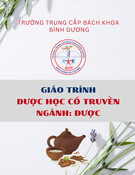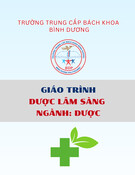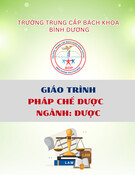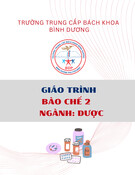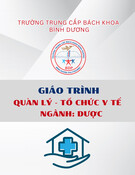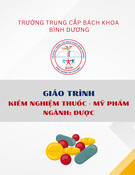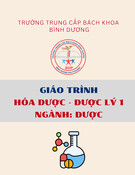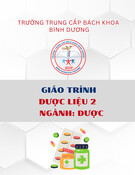
T.T.Xuan Loc, N.T.Thuy An / Tạp chí Khoa học và Công nghệ Đại học Duy Tân 02(69) (2025) 41-49
41
D U Y T A N U N I V E R S I T Y
A study on the chemical composition and antioxidant effects of
Melodorum fruticosum Lour. collected in Quang Nam
Nghiên cứu thành phần hóa học và tác dụng chống oxy hóa của cây Dủ dẻ trâu
(Melodorum fruticosum Lour.) thu hái tại Quảng Nam
Tran Thi Xuan Loca, Nguyen Thi Thuy Ana*
Trần Thị Xuân Lộca, Nguyễn Thị Thúy Ana*
aFaculty of Pharmacy, Medicine & Pharmacy Division, Duy Tan University, Da Nang, 550000, Viet Nam
aKhoa Dược, Khối Y Dược, Ðại học Duy Tân, Ðà Nẵng, Việt Nam
(Date of receiving article: 02/12/2024, date of completion of review: 19/02/2025, date of acceptance for publishing:
01/4/2025)
Abstract
Melodorum fruticosum Lour. (Annonaceae) contains various important bioactive compounds, including flavonoids,
heptenes, and essential oils. However, no studies have been conducted to investigate or quantify these compound groups
in Melodorum fruticosum Lour. from Quang Nam. Several studies have explored its cytotoxic, anti-inflammatory, and
antioxidant effects. There is only one research article on the antioxidant effects of flower essential oils. To enrich the
existing data on this plant, this study was conducted to determine the chemical components, flavonoid content, and
antioxidant effects of leaf and stem extracts of Melodorum fruticosum Lour. collected in Quang Nam. Chemical analysis
employing chemical reactions and thin-layer chromatography revealed the presence of flavonoids, coumarins, tannins,
polysaccharides, lipids, and sterols in both stems and leaves. Additionally, leaves were found to contain carotenes. Total
flavonoid quantification using the colorimetric AlCl3 method and quercetin (QE) standard curve yielded 37.80 mg/g for
leaves and 15.07 mg/g for stems (calculated based on quercetin equivalence). Antioxidant activity evaluation using the
1,1-diphenyl-2-picrylhydrazyl (DPPH) method indicated an IC50 value of 5575.60 µg/ml for stems and 2292.62 µg/ml for
leaves, based on the dry weight of the medicinal material, demonstrating the superior antioxidant capacity of leaves
compared to stems. These findings provide valuable insights into the chemical composition and antioxidant activities of
Melodorum fruticosum Lour. and suggest further exploration of leaf extracts for in-depth investigations into the plant's
chemistry and biological effects.
Keywords: Melodorum fruticosum Lour.; chemical composition; antioxidant effects.
Tóm tắt
Cây Dủ dẻ trâu (Melodorum fruticosum Lour.), họ Na (Annonaceae) có chứa nhiều hoạt chất quan trọng như flavonoid,
hepten, tinh dầu,... Tuy nhiên, chưa có bài nghiên cứu nào khảo sát sự có mặt hay định lượng các nhóm hợp chất trong
cây Dủ dẻ trâu ở Quảng Nam. Một số nghiên cứu đã thử nghiệm tác dụng gây độc tế bào ung thư, chống viêm và chống
oxy hóa. Trong đó chỉ có một bài nghiên cứu về tác dụng chống oxy hóa từ tinh dầu hoa. Để góp phần bổ sung thêm các
dữ liệu về loài cây này, nghiên cứu này được thực hiện nhằm tiến hành xác định các thành phần hóa học, hàm lượng của
flavonoid và tác dụng chống oxy hóa từ dịch chiết lá và thân cây Dủ dẻ trâu thu hái ở Quảng Nam. Các hợp chất chính
trong cây được xác định bằng các phản ứng hóa học và sắc ký lớp mỏng cho thấy cả thân và lá đều có flavonoid, coumarin,
tanin, polysaccharid, chất béo và sterol; ngoài ra lá cây còn có caroten. Hàm lượng flavonoid toàn phần được xác định
*Corresponding author: Nguyen Thi Thuy An
Email: nguyentthuyan16@dtu.edu.vn
02(69) (2025) 41-49
DTU Journal of Science and Technology

T.T.Xuan Loc, N.T.Thuy An / Tạp chí Khoa học và Công nghệ Đại học Duy Tân 02(69) (2025) 41-49
42
theo phương pháp tạo màu với AlCl3 và xây dựng đường chuẩn với quercetin (QE), trong lá đạt 37,80 mg/g, trong thân
đạt 15,07 mg/g tính theo quercetin. Sử dụng phương pháp 1,1-diphenyl-2-picrylhydrazyl (DPPH) để khảo sát tác dụng
chống oxy hóa cho thấy giá trị IC50 của thân là 5575,60 µg/ml và cao hơn giá trị IC50 của lá là 2292,62 µg/ml. Điều đó
cho thấy khả năng chống oxy hóa của thân thấp hơn so với lá. Các kết quả của đề tài góp phần làm tiền đề, gợi ý việc lựa
chọn lá để tiếp tục thực hiện thêm các nghiên cứu chuyên sâu hơn về hóa học và tác dụng sinh học của cây Dủ dẻ trâu.
Từ khóa: Dủ dẻ trâu; thành phần hoá học; tác dụng chống oxy hóa.
1. Introduction
Melodorum fruticosum Lour. is a species of
plant in the Annonaceae [3]. It is native to
Southeast Asia, including Vietnam. The fruit is
edible, with a sweet or sour taste, and is often
used to make beverages or wine [15]. The bark
can be used as a betel quid. The leaves, bark, and
branches can be used to make a tea that aids
digestion. The flowers can be used to make
perfume, or eaten raw. They have a sweet taste
and are used to treat fever, dizziness, and
headaches. They can also be used to treat heart
disease and hypertension [11].
Research on the chemistry, as well as the
compounds isolated from M. fruticosum Lour.,
is still relatively limited. The parts of the plant
that are most often studied are the stems, bark,
leaves, or flowers. Studies of the chemical
composition of M. fruticosum Lour. have shown
that heptane derivatives and flavonoids are the
most common compounds isolated from the
plant. Other groups of compounds that have
been isolated or extracted from the plant include
steroids, essential oils, and aromatic compounds
[5], [9]. Researchers have investigated the
activities of these isolated compounds, such as
cancer cell inhibition, anti-inflammatory
activity, and antioxidant activity [7], [13], [14].
These studies have shown the potential of M.
fruticosum Lour. as a medicinal plant.
This study aims to analyze and identify the
chemical constituents of M. fruticosum Lour.,
with a particular emphasis on quantifying
flavonoids and assessing its antioxidant
properties. The findings aim to provide valuable
insights into the species and reinforce its
potential as a medicinal resource and
contributing to the advancement of natural
medicinal materials in Vietnam.
2. Subjects, time and research methods
2.1. Subjects and research time
Melodorum fruticosum Lour., harvested in
Binh Son commune, Hiep Duc district, Quang
Nam province, was used as the research subject.
The plant includes the following parts: the stems
and the leaves. The study was conducted from
January 2021 to May 2022.
Based on the morphological characteristics of
the research samples, using the genus
classification key Melodorum, comparing the
species description with reference [3], the
research samples were accurately identified by
their scientific name as Melodorum fruticosum
Lour. [17], and the specimen is stored at the
Department of Medicinal Botany -
Pharmacognosy - Traditional Medicine, Faculty
of Pharmacy, College of Medicine and
Pharmacy, Duy Tan University, under the code
KDDTU-01.
Sample preparation: The stems and leaves of
the plant were collected, washed, chopped,
dried, and ground into powder. The powder was
placed in a sealed container and stored in a cool,
dry place. The moisture content of the stems was
found to be 10.737% and that of the leaves was
12.613%.
2.2. Research methods
2.2.1. Determination by chemical reactions
Specific reagents were used to identify
common medicinal herb compound groups in
the leaves and stems of Melodorum fruticosum

T.T.Xuan Loc, N.T.Thuy An / Tạp chí Khoa học và Công nghệ Đại học Duy Tân 02(69) (2025) 41-49
43
Lour. through chemical reactions using standard
methods with modification as reported by Devi
et al. [6] and Bhardwaj et al. [4]. Depending on
the compound type, the powder was extracted
using 80° alcohol (for flavonoids and
coumarins), water (for tannins, organic acids,
amino acids, reducing sugars), or petroleum
ether (for lipids, carotenes, sterols), or other
suitable solvents.
2.2.2. Determination by thin-layer chromatography
Determine the conditions for conducting thin-
layer chromatography, referring to the procedure
in Appendix 5.4 of Vietnam Pharmacopoeia V
[8]. Concentrate the petroleum ether extract and
the 80° alcohol extract (prepared in the
qualitative part by chemical reaction). Dilute the
petroleum ether extract with petroleum ether and
the alcohol extract with MeOH to obtain test
solutions. Subsequently, develop and record the
chromatograms.
2.2.3. Survey of flavonoid content
Total flavonoid content (TFC) was determined
spectrophotometrically at a wavelength of 510 nm.
A standard curve was constructed using quercetin
(QE) as the standard [2].
TFC was expressed as milligrams of
quercetin equivalent per gram of dried medicine
material (mg QE/g medicine material), using the
following formula:
𝑇𝐹𝐶 = 𝐶 𝑥 𝑉 𝑥 𝑘
1000 𝑥 𝑚 𝑥 (100−𝐻) 𝑥 100
TFC: Total flavonoid content (mg QE/g
medicine material);
C: Quercetin concentration determined from
standard curve (μg/ml);
V: Volume of test solution (ml);
k: Dilution factor;
m: Mass of medicine material (g);
H: Moisture content of medicine material (%).
2.2.4. Determination of antioxidant activity
The antioxidant activity was determined
using the DPPH free radical scavenging method
at a wavelength of 517 nm [1]. Antioxidant
activity (I%) was calculated using the following
formula:
I% = 𝐴𝑐−𝐴𝑡
𝐴𝑐 x 100
I%: DPPH antioxidant effect;
Ac: control tube optical density;
At: test tube optical density.
3. Research and discussion
3.1. Qualitative results of compound groups using chemical methods
Table 1. Qualitative results of organic compound group detection in the Melodorum fruticosum
Lour. stems and leaves using chemical reactions.
Serial
Compound
Chemical reactions
Result
Conclude
Stems
Leaves
Stems
Leaves
1
Alkaloids
Mayer's reagent
(-)
(-)
(-)
(-)
Dragendorff's reagent
(-)
(-)
2
Cardiac glycosides
Liebermann-Burchard
reaction
(-)
(-)
(-)
(-)
Legal's reaction
(-)
(-)
Baljet reaction
(-)
(-)
3
Anthranoids
Borntraeger reaction
(-)
(-)
(-)
(-)
4
Flavonoids
Cyanidin reaction
(+)
(+)
(+)
(+)
5
Coumarins
Lactone ring opening
reaction
(+)
(+)
(+)
(+)

T.T.Xuan Loc, N.T.Thuy An / Tạp chí Khoa học và Công nghệ Đại học Duy Tân 02(69) (2025) 41-49
44
6
Saponins
Foaming reaction
(+)
(+)
(+)
(+)
7
Tannins
Reaction with 5%
FeCl3
(+)
(+)
(+)
(+)
Reaction with 1%
gelatin
(+)
(+)
8
Reducing sugar
Fehling's test
(-)
(-)
(-)
(-)
9
Polysaccharides
Bouchardat's test
(+)
(+)
(+)
(+)
10
Lipids
Evaporation of the
solvent by heating
(+)
(+)
(+)
(+)
11
Sterols
Liebermann-Burchard
reaction
(+)
(+)
(+)
(+)
12
Carotenes
Reaction with H2SO4
(-)
(+)
(-)
(+)
Note: (-) negative; (+) positive
Preliminary chemical reactions revealed the
presence of the following compound groups in
the stems of the M. fruticosum: flavonoids,
coumarins, saponins, tannins, polysaccharides,
lipids, and sterols. Additionally, the leaves were
found to contain flavonoids, coumarins,
saponins, tannins, polysaccharides, lipids,
sterols, and carotenes.
Chemical studies on M. fruticosum primarily
focus on isolation and extraction of compound
groups such as flavonoids, steroids, essential
oils, and aromatic compounds. The results of the
investigation confirm the presence of
corresponding compound groups as indicated in
the literature. Qualitative analysis reveals the
presence of flavonoid groups in both the stems
and leaves, consistent with previous studies [7],
[9], [10], [18]. Additionally, qualitative
assessment confirms the presence of sterol
groups in both the stems and leaves, whereas
earlier studies had only isolated sterol compound
groups from the stem bark [10], [16]. The
research has provided supplementary insights
into the presence of other compounds such as
coumarins, saponins, tannins, polysaccharides,
and lipids in both the stems and leaves, as well
as the presence of carotenoid groups in the
leaves.
3.2. Results of qualitative analysis of compound
groups by thin-layer chromatography
After extraction, the following extracts were
obtained: petroleum ether extract of stems (PT),
petroleum ether extract of leaves (PL), alcohol
extract of stems (CT), and alcohol extract of
leaves (CL). After several trials on different
solvent systems, it was found that the petroleum
ether extracts (PT, PL) separated well on the
petroleum ether: chloroform: ethyl acetate
(12:3:1) system, and the alcohol extracts (CT,
CL) separated well on the toluene: ethyl acetate:
formic acid (5:3:0.2) system (Figure 1, Figure
2).
System I: Petroleum ether: Chloroform: Ethyl
acetate (12:3:1): Both leaf and stem ether
extracts showed spots I9 and I15 after
development on the system I. The remaining
spots appeared independently on each extract
type. Spot I9 turned purple after spraying with
10% H2SO4 reagent, suggesting the presence of
steroid compounds.

T.T.Xuan Loc, N.T.Thuy An / Tạp chí Khoa học và Công nghệ Đại học Duy Tân 02(69) (2025) 41-49
45
Figure 1. Chromatogram of stem and leaf petroleum ether on the solvent system Petroleum ether:
Chloroform: Ethyl acetate (12:3:1)
System II: Toluene: Ethyl acetate: Acid
formic (5:3:0.2): Leaf and stem alcohol extracts
showed spots II1, II2, II11, and II14 after
developing on system II. The remaining spots
appeared independently on each extract type.
Spots II3, II4, II5, II8, and II11 were visible
under both UV 254 nm and UV 365 nm light and
after spraying with reagents. Spot II5 turned
blackish-blue after spraying with FeCl3 reagent,
suggesting the presence of polyphenol
compounds.
Figure 2. Chromatogram of stem and leaf alcohol on Toluene: Ethyl acetate: Formic acid solvent system (5:3:0,.2)
FeCl3 reagent was not utilized in the System
I (to detect traces of polyphenol compound
groups) as the primarily non-polar compounds
are present in this spot. Chromatographic results
indicated the potential presence of steroid
compound groups in the petroleum ether extract
of the plant and polyphenol groups in the alcohol
extract, consistent with the findings of chemical
methods. Furthermore, the results revealed
differences between the stems and leaves.











![Bài giảng Dược động học [chuẩn nhất]](https://cdn.tailieu.vn/images/document/thumbnail/2025/20251122/s236884@nctu.edu.vn/135x160/93751763955471.jpg)



